Audit Procedures and Internal Controls in Financial Reporting Audit
VerifiedAdded on 2023/06/15
|9
|1524
|238
Report
AI Summary
This report provides a detailed analysis of audit procedures and internal controls within the context of financial reporting. It addresses key areas such as substantive procedures for auditing capital expenditure and depreciation, steps for verifying bank reconciliations, advantages and disadvantages of cash flow valuation, and internal controls related to investment functions. The report also includes an assessment of statements related to audit procedures and their impact on material misstatements. This document is a valuable resource for students studying finance and auditing, offering insights into practical applications and theoretical concepts.
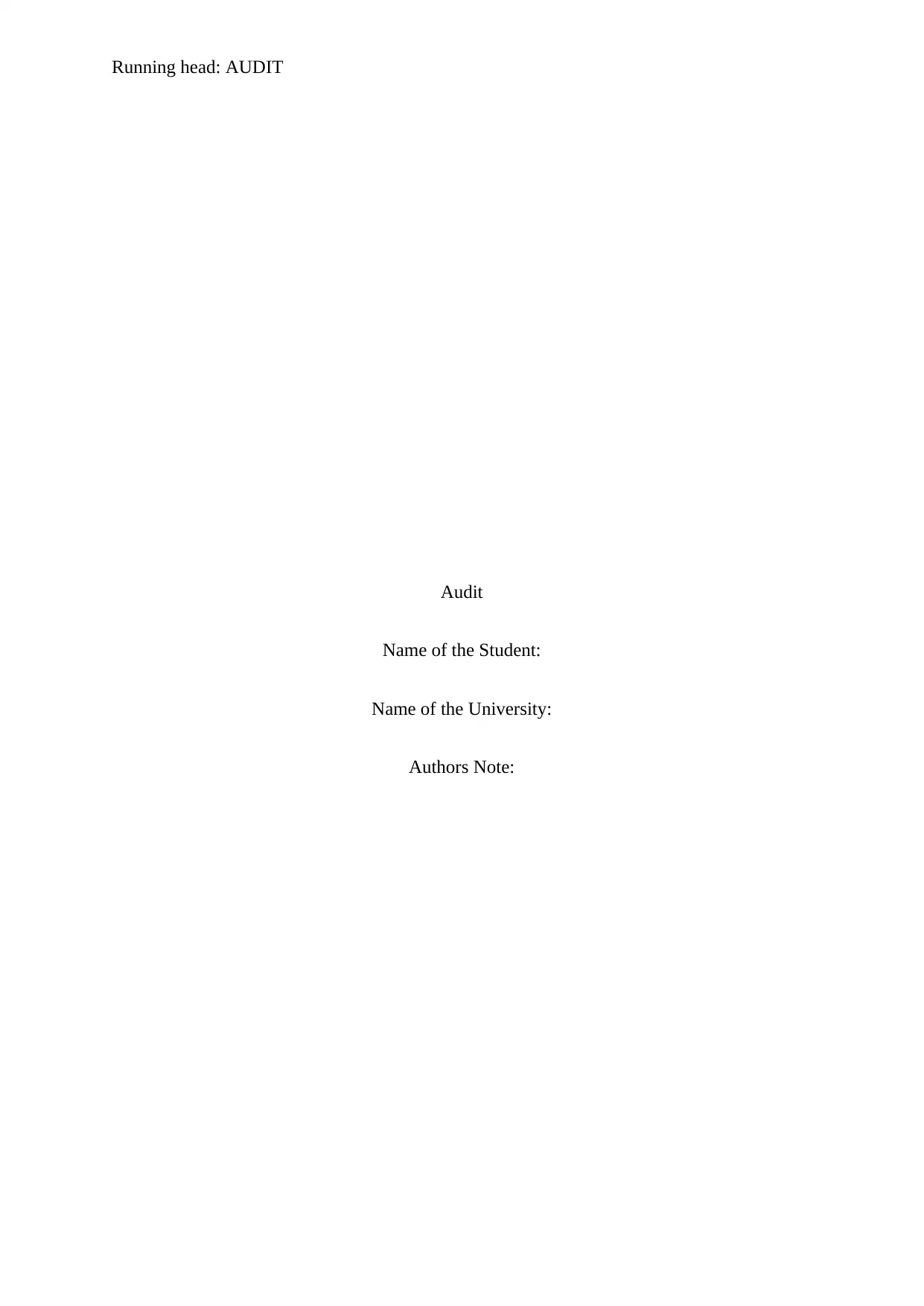
Running head: AUDIT
Audit
Name of the Student:
Name of the University:
Authors Note:
Audit
Name of the Student:
Name of the University:
Authors Note:
Paraphrase This Document
Need a fresh take? Get an instant paraphrase of this document with our AI Paraphraser
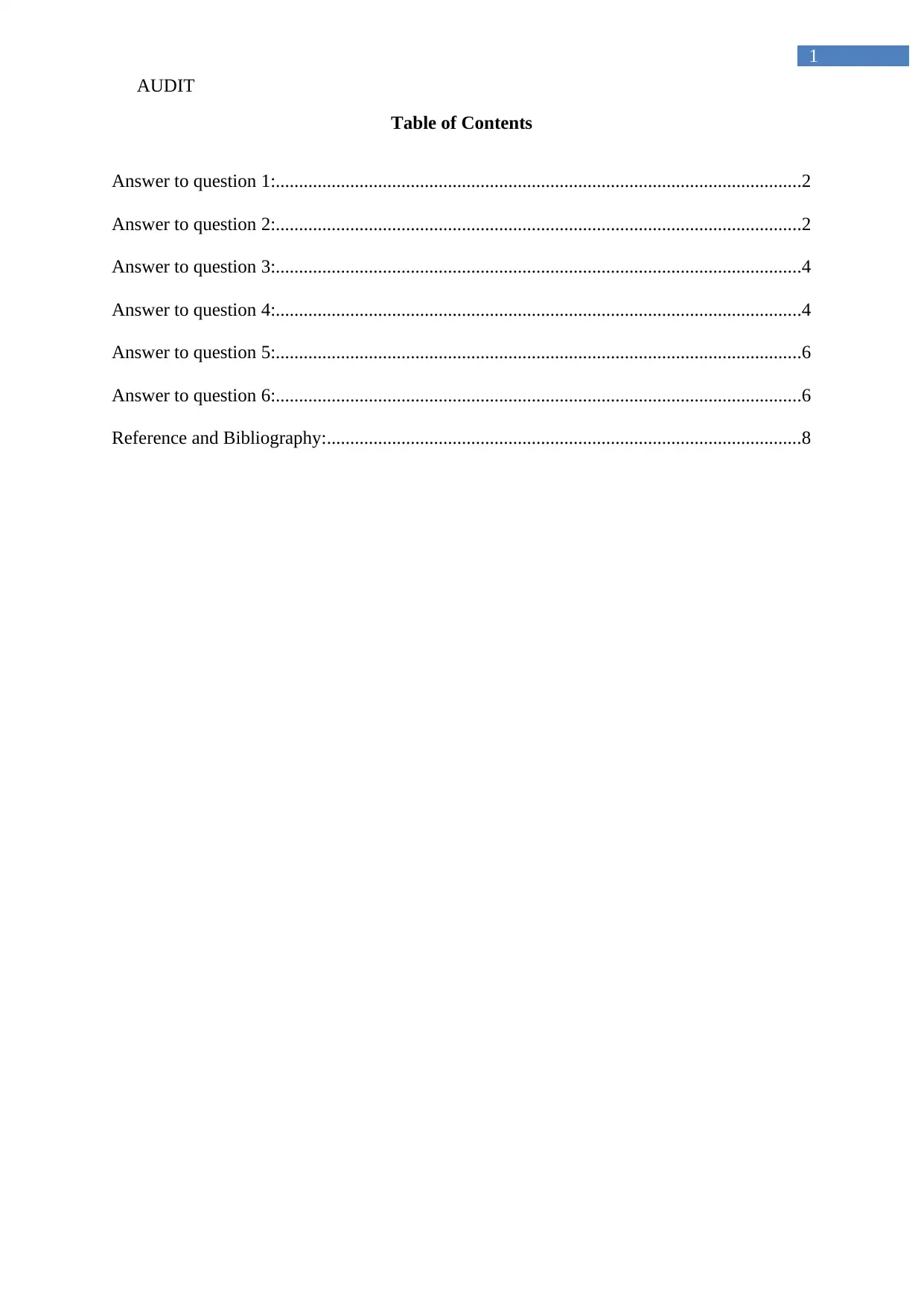
AUDIT
1
Table of Contents
Answer to question 1:.................................................................................................................2
Answer to question 2:.................................................................................................................2
Answer to question 3:.................................................................................................................4
Answer to question 4:.................................................................................................................4
Answer to question 5:.................................................................................................................6
Answer to question 6:.................................................................................................................6
Reference and Bibliography:......................................................................................................8
1
Table of Contents
Answer to question 1:.................................................................................................................2
Answer to question 2:.................................................................................................................2
Answer to question 3:.................................................................................................................4
Answer to question 4:.................................................................................................................4
Answer to question 5:.................................................................................................................6
Answer to question 6:.................................................................................................................6
Reference and Bibliography:......................................................................................................8
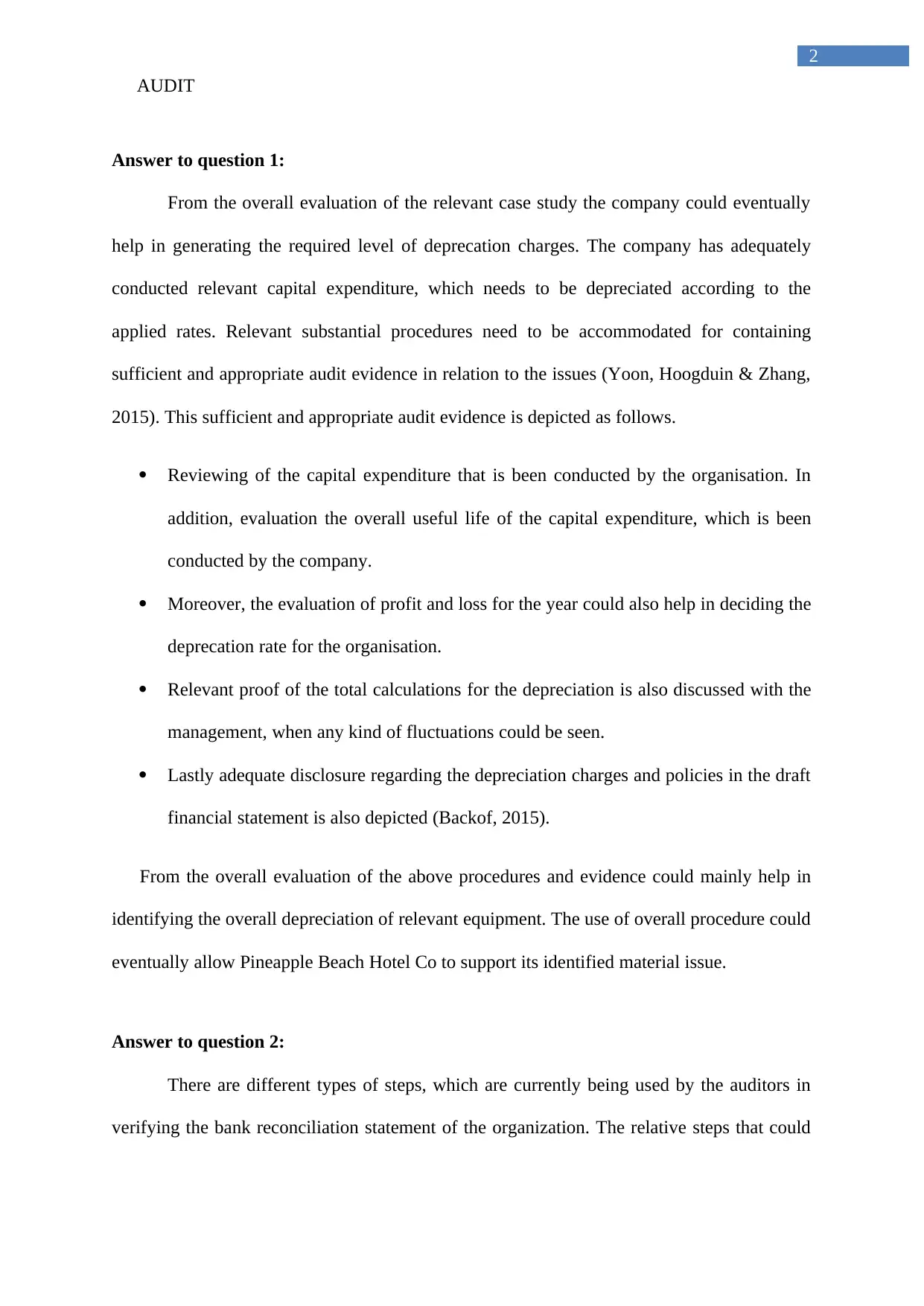
AUDIT
2
Answer to question 1:
From the overall evaluation of the relevant case study the company could eventually
help in generating the required level of deprecation charges. The company has adequately
conducted relevant capital expenditure, which needs to be depreciated according to the
applied rates. Relevant substantial procedures need to be accommodated for containing
sufficient and appropriate audit evidence in relation to the issues (Yoon, Hoogduin & Zhang,
2015). This sufficient and appropriate audit evidence is depicted as follows.
Reviewing of the capital expenditure that is been conducted by the organisation. In
addition, evaluation the overall useful life of the capital expenditure, which is been
conducted by the company.
Moreover, the evaluation of profit and loss for the year could also help in deciding the
deprecation rate for the organisation.
Relevant proof of the total calculations for the depreciation is also discussed with the
management, when any kind of fluctuations could be seen.
Lastly adequate disclosure regarding the depreciation charges and policies in the draft
financial statement is also depicted (Backof, 2015).
From the overall evaluation of the above procedures and evidence could mainly help in
identifying the overall depreciation of relevant equipment. The use of overall procedure could
eventually allow Pineapple Beach Hotel Co to support its identified material issue.
Answer to question 2:
There are different types of steps, which are currently being used by the auditors in
verifying the bank reconciliation statement of the organization. The relative steps that could
2
Answer to question 1:
From the overall evaluation of the relevant case study the company could eventually
help in generating the required level of deprecation charges. The company has adequately
conducted relevant capital expenditure, which needs to be depreciated according to the
applied rates. Relevant substantial procedures need to be accommodated for containing
sufficient and appropriate audit evidence in relation to the issues (Yoon, Hoogduin & Zhang,
2015). This sufficient and appropriate audit evidence is depicted as follows.
Reviewing of the capital expenditure that is been conducted by the organisation. In
addition, evaluation the overall useful life of the capital expenditure, which is been
conducted by the company.
Moreover, the evaluation of profit and loss for the year could also help in deciding the
deprecation rate for the organisation.
Relevant proof of the total calculations for the depreciation is also discussed with the
management, when any kind of fluctuations could be seen.
Lastly adequate disclosure regarding the depreciation charges and policies in the draft
financial statement is also depicted (Backof, 2015).
From the overall evaluation of the above procedures and evidence could mainly help in
identifying the overall depreciation of relevant equipment. The use of overall procedure could
eventually allow Pineapple Beach Hotel Co to support its identified material issue.
Answer to question 2:
There are different types of steps, which are currently being used by the auditors in
verifying the bank reconciliation statement of the organization. The relative steps that could
⊘ This is a preview!⊘
Do you want full access?
Subscribe today to unlock all pages.

Trusted by 1+ million students worldwide
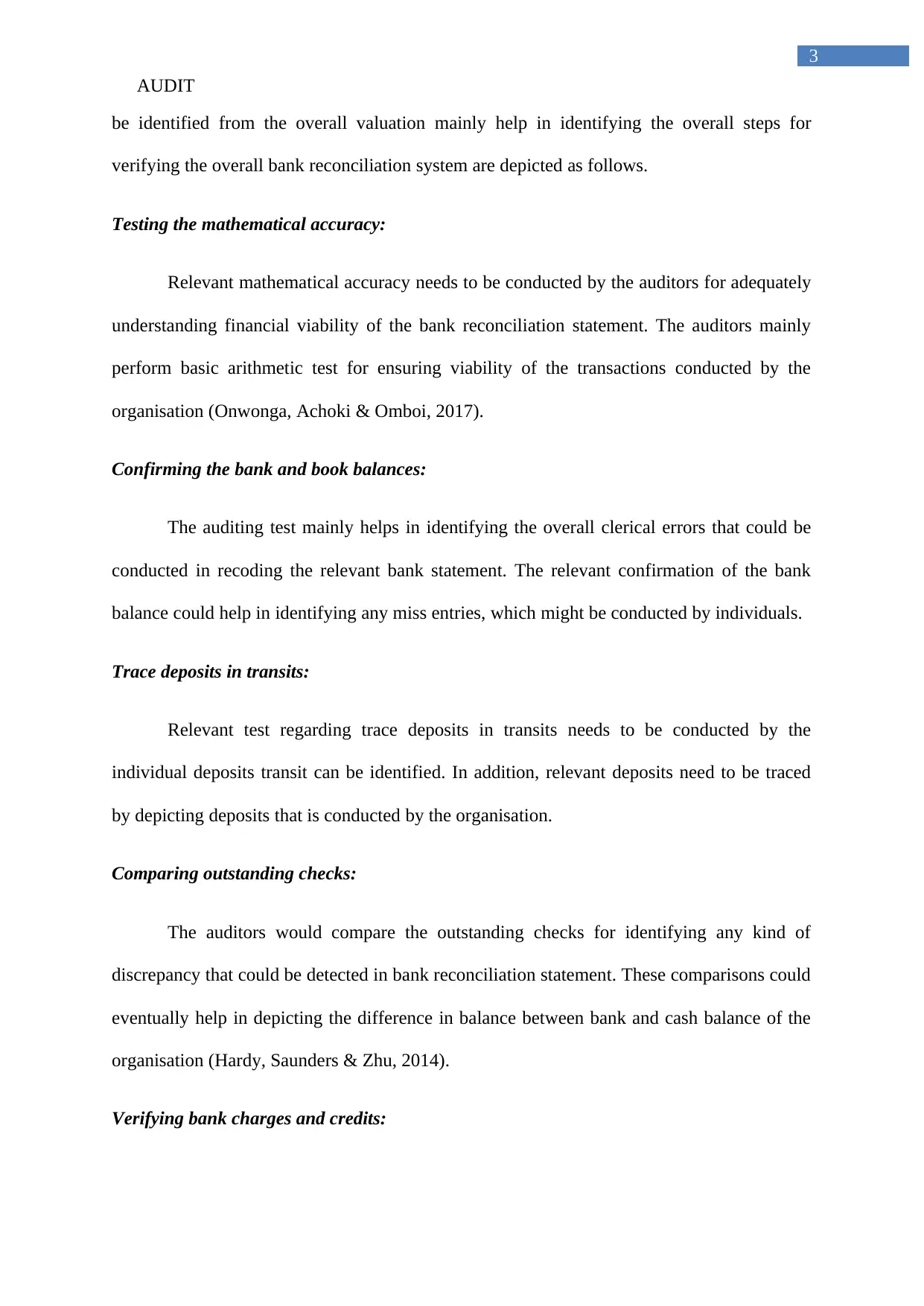
AUDIT
3
be identified from the overall valuation mainly help in identifying the overall steps for
verifying the overall bank reconciliation system are depicted as follows.
Testing the mathematical accuracy:
Relevant mathematical accuracy needs to be conducted by the auditors for adequately
understanding financial viability of the bank reconciliation statement. The auditors mainly
perform basic arithmetic test for ensuring viability of the transactions conducted by the
organisation (Onwonga, Achoki & Omboi, 2017).
Confirming the bank and book balances:
The auditing test mainly helps in identifying the overall clerical errors that could be
conducted in recoding the relevant bank statement. The relevant confirmation of the bank
balance could help in identifying any miss entries, which might be conducted by individuals.
Trace deposits in transits:
Relevant test regarding trace deposits in transits needs to be conducted by the
individual deposits transit can be identified. In addition, relevant deposits need to be traced
by depicting deposits that is conducted by the organisation.
Comparing outstanding checks:
The auditors would compare the outstanding checks for identifying any kind of
discrepancy that could be detected in bank reconciliation statement. These comparisons could
eventually help in depicting the difference in balance between bank and cash balance of the
organisation (Hardy, Saunders & Zhu, 2014).
Verifying bank charges and credits:
3
be identified from the overall valuation mainly help in identifying the overall steps for
verifying the overall bank reconciliation system are depicted as follows.
Testing the mathematical accuracy:
Relevant mathematical accuracy needs to be conducted by the auditors for adequately
understanding financial viability of the bank reconciliation statement. The auditors mainly
perform basic arithmetic test for ensuring viability of the transactions conducted by the
organisation (Onwonga, Achoki & Omboi, 2017).
Confirming the bank and book balances:
The auditing test mainly helps in identifying the overall clerical errors that could be
conducted in recoding the relevant bank statement. The relevant confirmation of the bank
balance could help in identifying any miss entries, which might be conducted by individuals.
Trace deposits in transits:
Relevant test regarding trace deposits in transits needs to be conducted by the
individual deposits transit can be identified. In addition, relevant deposits need to be traced
by depicting deposits that is conducted by the organisation.
Comparing outstanding checks:
The auditors would compare the outstanding checks for identifying any kind of
discrepancy that could be detected in bank reconciliation statement. These comparisons could
eventually help in depicting the difference in balance between bank and cash balance of the
organisation (Hardy, Saunders & Zhu, 2014).
Verifying bank charges and credits:
Paraphrase This Document
Need a fresh take? Get an instant paraphrase of this document with our AI Paraphraser
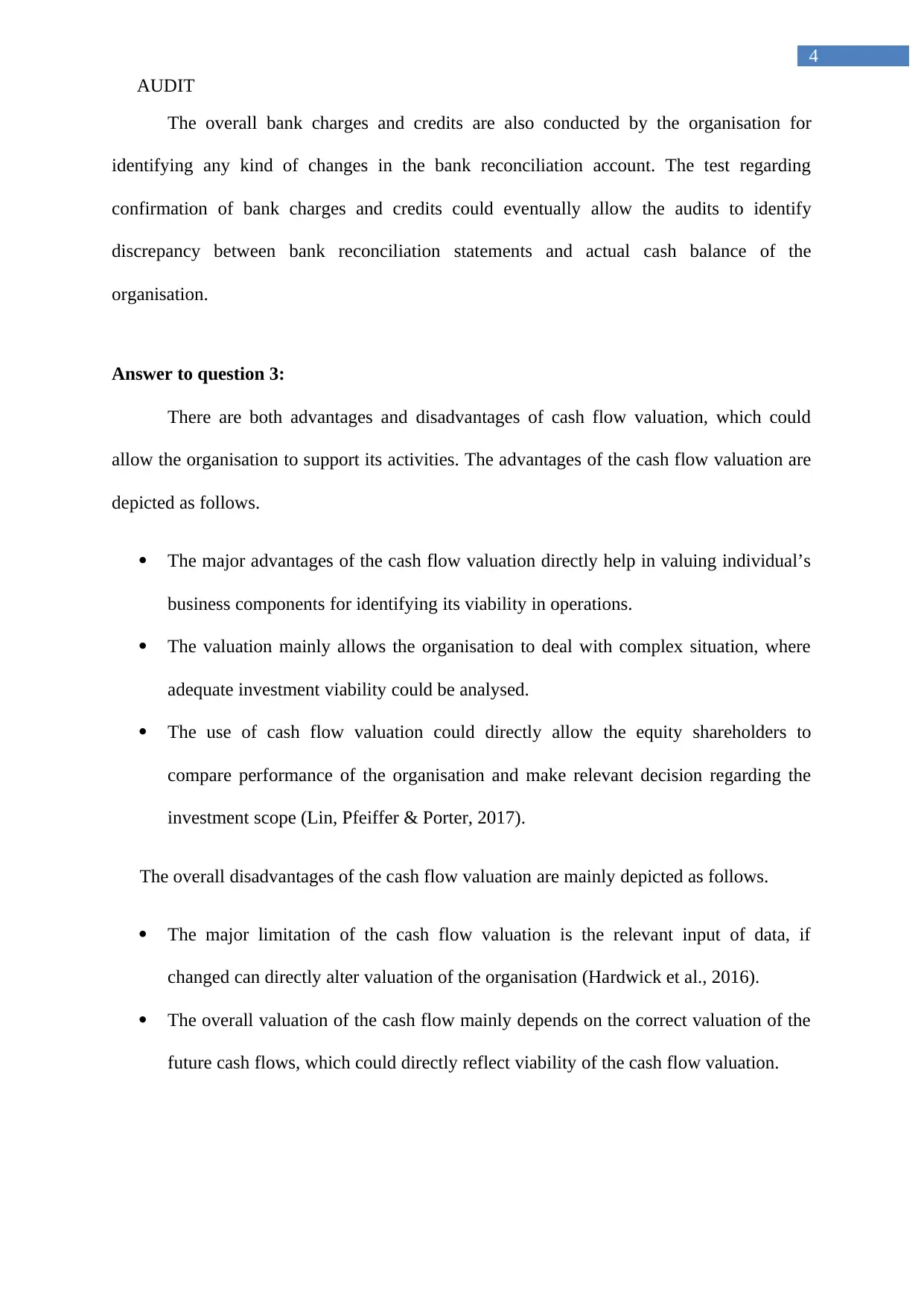
AUDIT
4
The overall bank charges and credits are also conducted by the organisation for
identifying any kind of changes in the bank reconciliation account. The test regarding
confirmation of bank charges and credits could eventually allow the audits to identify
discrepancy between bank reconciliation statements and actual cash balance of the
organisation.
Answer to question 3:
There are both advantages and disadvantages of cash flow valuation, which could
allow the organisation to support its activities. The advantages of the cash flow valuation are
depicted as follows.
The major advantages of the cash flow valuation directly help in valuing individual’s
business components for identifying its viability in operations.
The valuation mainly allows the organisation to deal with complex situation, where
adequate investment viability could be analysed.
The use of cash flow valuation could directly allow the equity shareholders to
compare performance of the organisation and make relevant decision regarding the
investment scope (Lin, Pfeiffer & Porter, 2017).
The overall disadvantages of the cash flow valuation are mainly depicted as follows.
The major limitation of the cash flow valuation is the relevant input of data, if
changed can directly alter valuation of the organisation (Hardwick et al., 2016).
The overall valuation of the cash flow mainly depends on the correct valuation of the
future cash flows, which could directly reflect viability of the cash flow valuation.
4
The overall bank charges and credits are also conducted by the organisation for
identifying any kind of changes in the bank reconciliation account. The test regarding
confirmation of bank charges and credits could eventually allow the audits to identify
discrepancy between bank reconciliation statements and actual cash balance of the
organisation.
Answer to question 3:
There are both advantages and disadvantages of cash flow valuation, which could
allow the organisation to support its activities. The advantages of the cash flow valuation are
depicted as follows.
The major advantages of the cash flow valuation directly help in valuing individual’s
business components for identifying its viability in operations.
The valuation mainly allows the organisation to deal with complex situation, where
adequate investment viability could be analysed.
The use of cash flow valuation could directly allow the equity shareholders to
compare performance of the organisation and make relevant decision regarding the
investment scope (Lin, Pfeiffer & Porter, 2017).
The overall disadvantages of the cash flow valuation are mainly depicted as follows.
The major limitation of the cash flow valuation is the relevant input of data, if
changed can directly alter valuation of the organisation (Hardwick et al., 2016).
The overall valuation of the cash flow mainly depends on the correct valuation of the
future cash flows, which could directly reflect viability of the cash flow valuation.
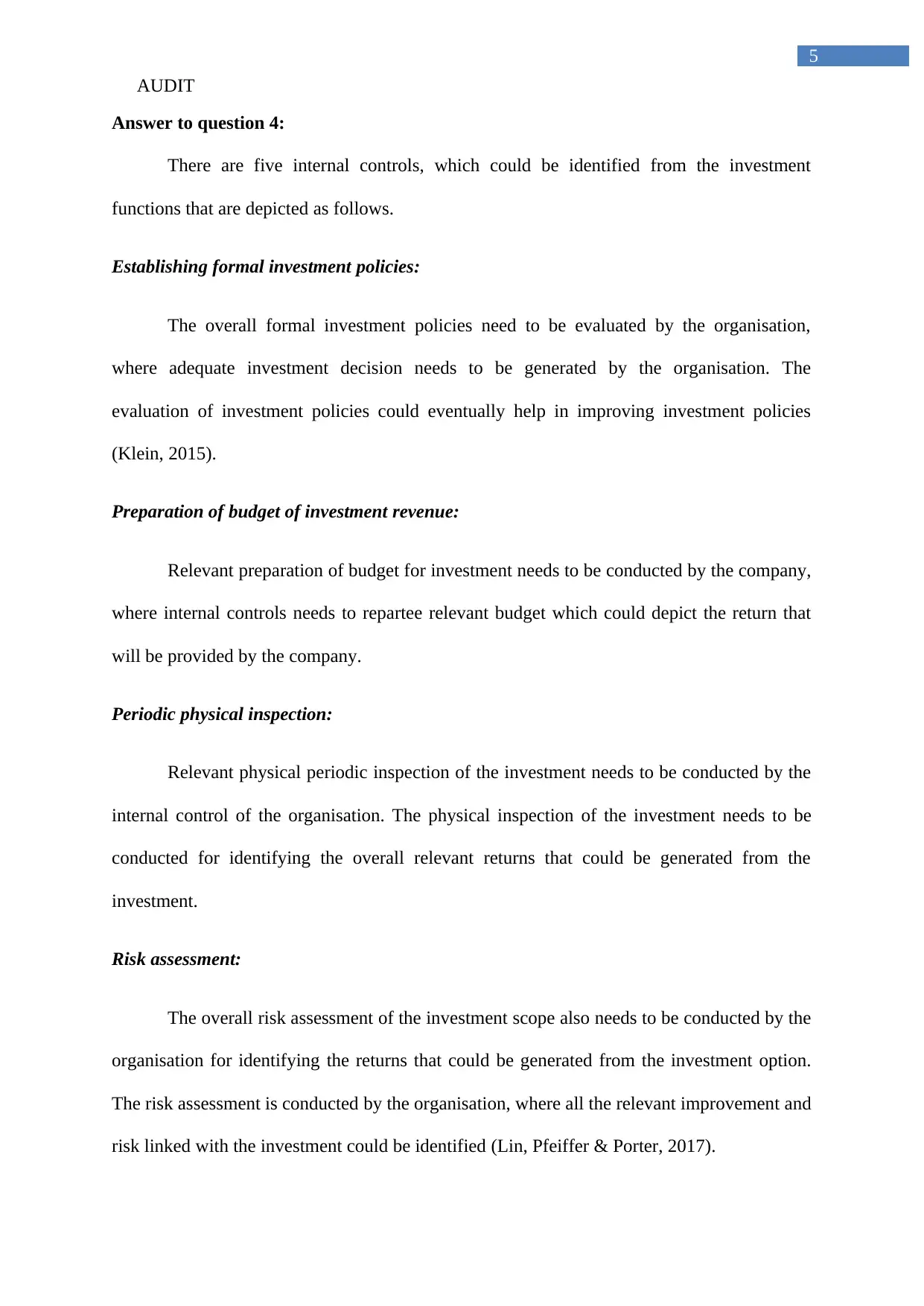
AUDIT
5
Answer to question 4:
There are five internal controls, which could be identified from the investment
functions that are depicted as follows.
Establishing formal investment policies:
The overall formal investment policies need to be evaluated by the organisation,
where adequate investment decision needs to be generated by the organisation. The
evaluation of investment policies could eventually help in improving investment policies
(Klein, 2015).
Preparation of budget of investment revenue:
Relevant preparation of budget for investment needs to be conducted by the company,
where internal controls needs to repartee relevant budget which could depict the return that
will be provided by the company.
Periodic physical inspection:
Relevant physical periodic inspection of the investment needs to be conducted by the
internal control of the organisation. The physical inspection of the investment needs to be
conducted for identifying the overall relevant returns that could be generated from the
investment.
Risk assessment:
The overall risk assessment of the investment scope also needs to be conducted by the
organisation for identifying the returns that could be generated from the investment option.
The risk assessment is conducted by the organisation, where all the relevant improvement and
risk linked with the investment could be identified (Lin, Pfeiffer & Porter, 2017).
5
Answer to question 4:
There are five internal controls, which could be identified from the investment
functions that are depicted as follows.
Establishing formal investment policies:
The overall formal investment policies need to be evaluated by the organisation,
where adequate investment decision needs to be generated by the organisation. The
evaluation of investment policies could eventually help in improving investment policies
(Klein, 2015).
Preparation of budget of investment revenue:
Relevant preparation of budget for investment needs to be conducted by the company,
where internal controls needs to repartee relevant budget which could depict the return that
will be provided by the company.
Periodic physical inspection:
Relevant physical periodic inspection of the investment needs to be conducted by the
internal control of the organisation. The physical inspection of the investment needs to be
conducted for identifying the overall relevant returns that could be generated from the
investment.
Risk assessment:
The overall risk assessment of the investment scope also needs to be conducted by the
organisation for identifying the returns that could be generated from the investment option.
The risk assessment is conducted by the organisation, where all the relevant improvement and
risk linked with the investment could be identified (Lin, Pfeiffer & Porter, 2017).
⊘ This is a preview!⊘
Do you want full access?
Subscribe today to unlock all pages.

Trusted by 1+ million students worldwide
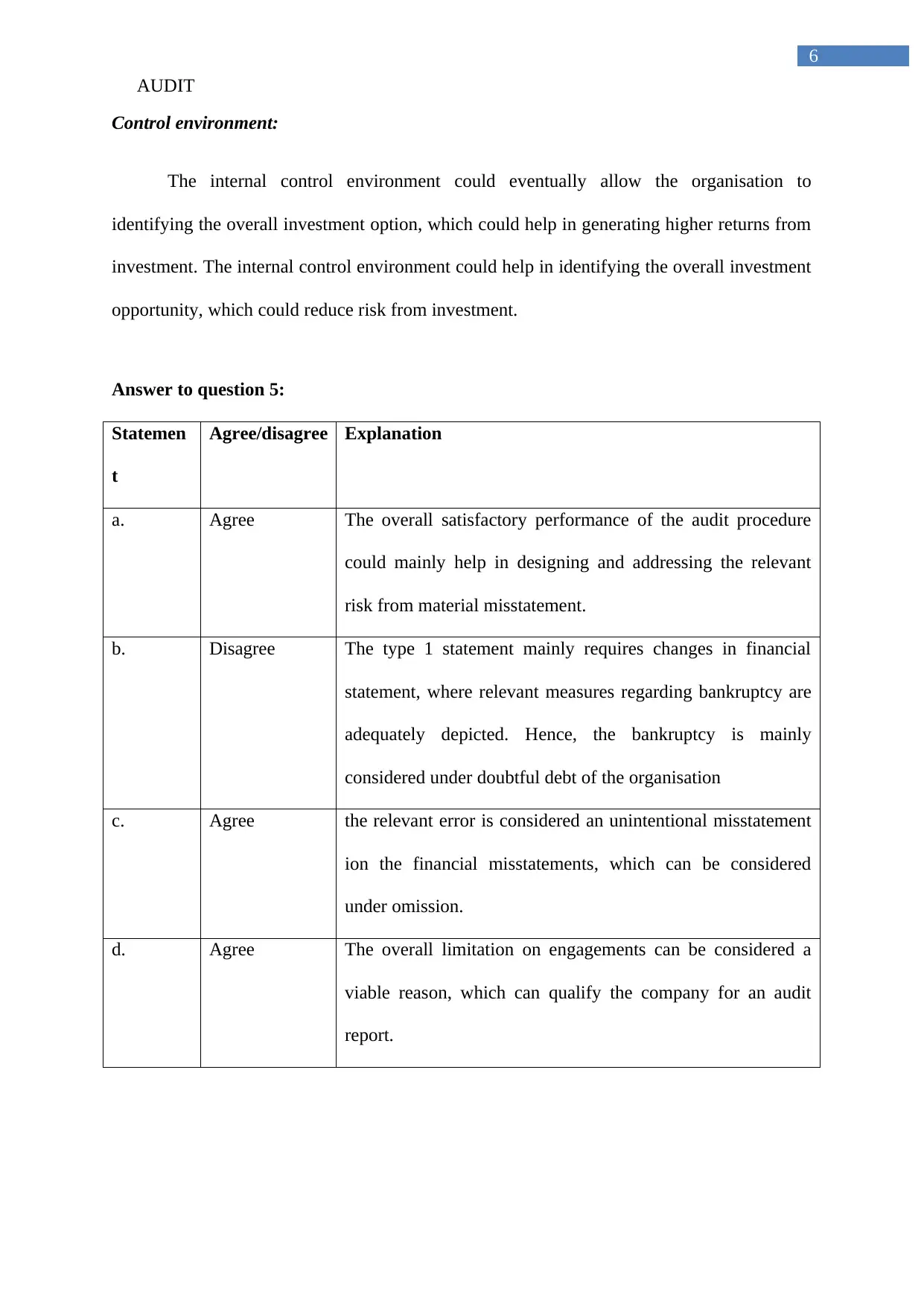
AUDIT
6
Control environment:
The internal control environment could eventually allow the organisation to
identifying the overall investment option, which could help in generating higher returns from
investment. The internal control environment could help in identifying the overall investment
opportunity, which could reduce risk from investment.
Answer to question 5:
Statemen
t
Agree/disagree Explanation
a. Agree The overall satisfactory performance of the audit procedure
could mainly help in designing and addressing the relevant
risk from material misstatement.
b. Disagree The type 1 statement mainly requires changes in financial
statement, where relevant measures regarding bankruptcy are
adequately depicted. Hence, the bankruptcy is mainly
considered under doubtful debt of the organisation
c. Agree the relevant error is considered an unintentional misstatement
ion the financial misstatements, which can be considered
under omission.
d. Agree The overall limitation on engagements can be considered a
viable reason, which can qualify the company for an audit
report.
6
Control environment:
The internal control environment could eventually allow the organisation to
identifying the overall investment option, which could help in generating higher returns from
investment. The internal control environment could help in identifying the overall investment
opportunity, which could reduce risk from investment.
Answer to question 5:
Statemen
t
Agree/disagree Explanation
a. Agree The overall satisfactory performance of the audit procedure
could mainly help in designing and addressing the relevant
risk from material misstatement.
b. Disagree The type 1 statement mainly requires changes in financial
statement, where relevant measures regarding bankruptcy are
adequately depicted. Hence, the bankruptcy is mainly
considered under doubtful debt of the organisation
c. Agree the relevant error is considered an unintentional misstatement
ion the financial misstatements, which can be considered
under omission.
d. Agree The overall limitation on engagements can be considered a
viable reason, which can qualify the company for an audit
report.
Paraphrase This Document
Need a fresh take? Get an instant paraphrase of this document with our AI Paraphraser
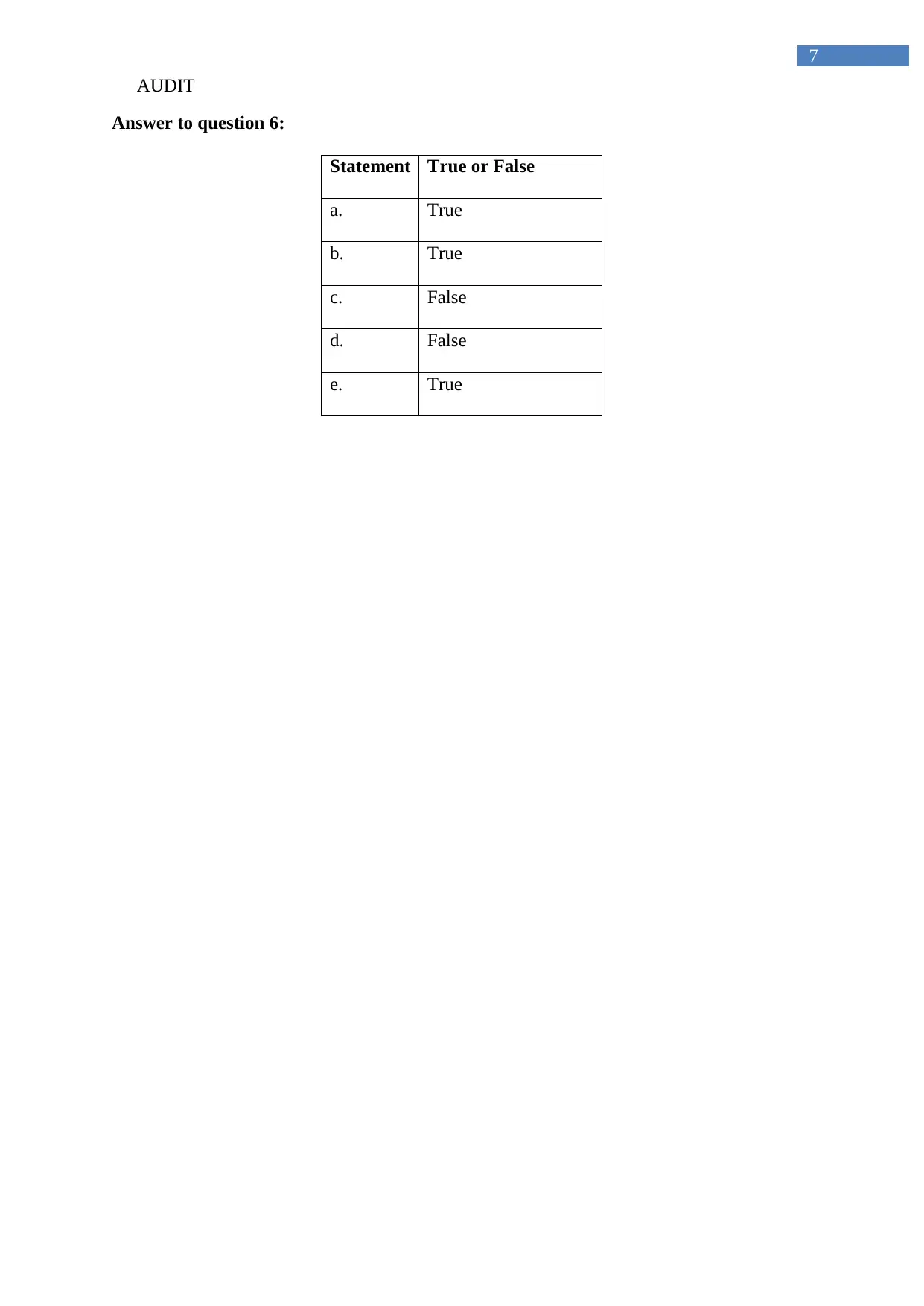
AUDIT
7
Answer to question 6:
Statement True or False
a. True
b. True
c. False
d. False
e. True
7
Answer to question 6:
Statement True or False
a. True
b. True
c. False
d. False
e. True
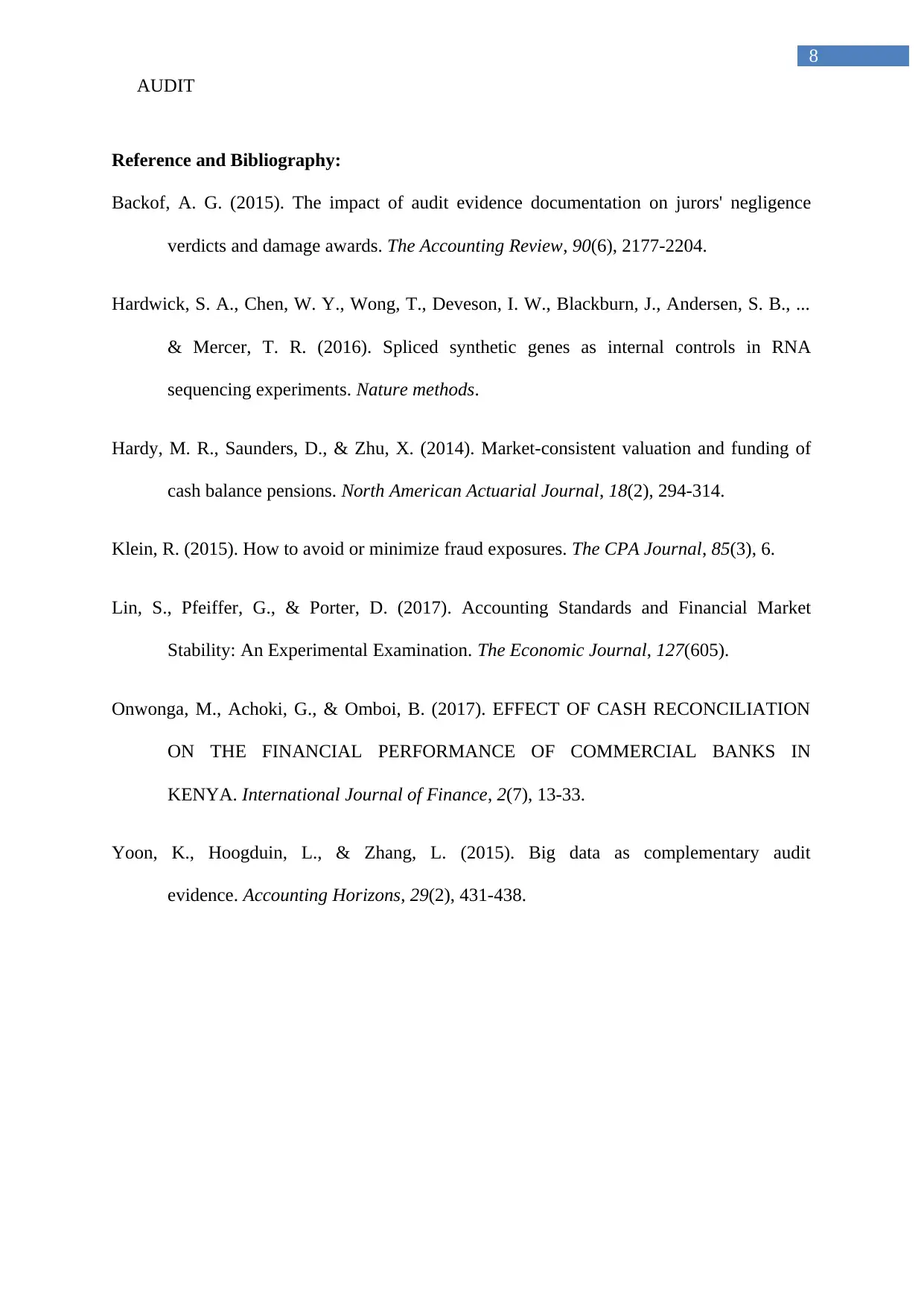
AUDIT
8
Reference and Bibliography:
Backof, A. G. (2015). The impact of audit evidence documentation on jurors' negligence
verdicts and damage awards. The Accounting Review, 90(6), 2177-2204.
Hardwick, S. A., Chen, W. Y., Wong, T., Deveson, I. W., Blackburn, J., Andersen, S. B., ...
& Mercer, T. R. (2016). Spliced synthetic genes as internal controls in RNA
sequencing experiments. Nature methods.
Hardy, M. R., Saunders, D., & Zhu, X. (2014). Market-consistent valuation and funding of
cash balance pensions. North American Actuarial Journal, 18(2), 294-314.
Klein, R. (2015). How to avoid or minimize fraud exposures. The CPA Journal, 85(3), 6.
Lin, S., Pfeiffer, G., & Porter, D. (2017). Accounting Standards and Financial Market
Stability: An Experimental Examination. The Economic Journal, 127(605).
Onwonga, M., Achoki, G., & Omboi, B. (2017). EFFECT OF CASH RECONCILIATION
ON THE FINANCIAL PERFORMANCE OF COMMERCIAL BANKS IN
KENYA. International Journal of Finance, 2(7), 13-33.
Yoon, K., Hoogduin, L., & Zhang, L. (2015). Big data as complementary audit
evidence. Accounting Horizons, 29(2), 431-438.
8
Reference and Bibliography:
Backof, A. G. (2015). The impact of audit evidence documentation on jurors' negligence
verdicts and damage awards. The Accounting Review, 90(6), 2177-2204.
Hardwick, S. A., Chen, W. Y., Wong, T., Deveson, I. W., Blackburn, J., Andersen, S. B., ...
& Mercer, T. R. (2016). Spliced synthetic genes as internal controls in RNA
sequencing experiments. Nature methods.
Hardy, M. R., Saunders, D., & Zhu, X. (2014). Market-consistent valuation and funding of
cash balance pensions. North American Actuarial Journal, 18(2), 294-314.
Klein, R. (2015). How to avoid or minimize fraud exposures. The CPA Journal, 85(3), 6.
Lin, S., Pfeiffer, G., & Porter, D. (2017). Accounting Standards and Financial Market
Stability: An Experimental Examination. The Economic Journal, 127(605).
Onwonga, M., Achoki, G., & Omboi, B. (2017). EFFECT OF CASH RECONCILIATION
ON THE FINANCIAL PERFORMANCE OF COMMERCIAL BANKS IN
KENYA. International Journal of Finance, 2(7), 13-33.
Yoon, K., Hoogduin, L., & Zhang, L. (2015). Big data as complementary audit
evidence. Accounting Horizons, 29(2), 431-438.
⊘ This is a preview!⊘
Do you want full access?
Subscribe today to unlock all pages.

Trusted by 1+ million students worldwide
1 out of 9
Related Documents
Your All-in-One AI-Powered Toolkit for Academic Success.
+13062052269
info@desklib.com
Available 24*7 on WhatsApp / Email
![[object Object]](/_next/static/media/star-bottom.7253800d.svg)
Unlock your academic potential
Copyright © 2020–2025 A2Z Services. All Rights Reserved. Developed and managed by ZUCOL.




